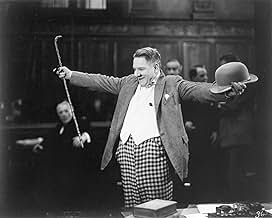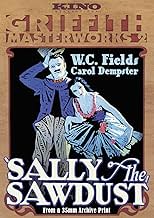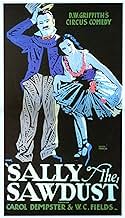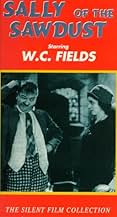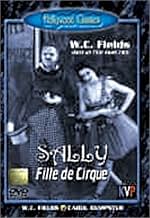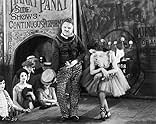Aggiungi una trama nella tua linguaJudge Foster throws his daughter out because she married a circus man. She leaves her baby girl with Prof. McGargle before she dies. Years later Sally is a dancer with whom Peyton, a son of ... Leggi tuttoJudge Foster throws his daughter out because she married a circus man. She leaves her baby girl with Prof. McGargle before she dies. Years later Sally is a dancer with whom Peyton, a son of Judge Foster's friend, falls in love. When Sally is arrested McGargle proves her real pare... Leggi tuttoJudge Foster throws his daughter out because she married a circus man. She leaves her baby girl with Prof. McGargle before she dies. Years later Sally is a dancer with whom Peyton, a son of Judge Foster's friend, falls in love. When Sally is arrested McGargle proves her real parentage.
- Regia
- Sceneggiatura
- Star
- Premi
- 3 vittorie totali
- Leon - the Acrobat
- (as Glen Anders)
- Stooge
- (non citato nei titoli originali)
- Bandit
- (non citato nei titoli originali)
- Bit Role
- (non citato nei titoli originali)
- Yokel in the Old Army Game
- (non citato nei titoli originali)
Recensioni in evidenza
Before Sally is born her well bred and off mother decides to run off with a show person against parents wishes and is disowned. With the father dead and the mother dying Poppy (Fields) agrees to return the child to her parents but then he decides to raise her himself. Together they tour and perform into her adulthood when the day of reckoning approaches, further complicated by Sally's romance with a swell and member of her grandparents polite society who disdain show people.
Directed by D.W. Griffith in the latter half of his career, Sally has a dated look for a 25 silent with many scenes hearkening back to his halcyon period a decade earlier as his famous montage style looks more like a Mack Sennett Keystone short in spots. Once again he focuses on societal hypocrisy and intolerance but it comes across hackneyed. Silent film had moved into its golden era and Griffith remained inert while Vidor, DeMille and Ingram were taking form and content to another level.
Fields is both funny and touching as he protects Sally and tries to make a living in a variety of dubious enterprises. Dempster is remarkably agile as she takes her licks in more than one scene as well as have a chameleon like look that goes from homely tomboy to deco sleek vamp. It is the energy and talent of both that carry Sally as they leave D.W. anachronistic style in the dust.
I did enjoy this film. I thought Carol Dempster was good in her role, but of course I was more interested in the times when Fields is on screen. There are some specific moments for Fields fans to savour. The fleeting shots of his juggling skills, the first evidence of the subtle reactions and gestures that we know from his classic talkies of the 1930's, and the peanut cart disguise for a liquor cabinet that survives from his Zeigfield Follies days.
This won't be a movie I turn to as often as I do to the great W.C. Fields films of 1932-34, but I'm just so glad that it has not been lost to us as have been other of Fields silent film work.
The breathtaking beauty of earlier D.W. Griffith-directed films is noticeably absent. While some of the shots are lovely, nothing equals the artfulness evident throughout many past Griffith efforts. "Sally of the Sawdust" is beautifully preserved (if only all Griffith prints were as well preserved); and, it is an enjoyable comedy (certainly more so in 1925). It was adapted from Dorothy Donnelly's popular play "Poppy" (1923), with Madge Kennedy and W.C. Fields. It was re-filmed as "Poppy" (1936), with Rochelle Hudson and W.C. Fields. Norma Talmadge's popular film was an altogether different "Poppy" (1917), and did not co-star W.C. Fields.
***** Sally of the Sawdust (8/2/25) D.W. Griffith ~ Carol Dempster, W.C. Fields, Alfred Lunt
However, he was not the "star" of this movie. That title would go to Carol Dempster. Dempster is something of a polarizing figure for silent film fans. Many have labeled her as a talentless and unattractive Lillian Gish wannabe whose supposedly awful performances led to DW Griffith's creative and commercial downfall. It's true that Dempster could be inconsistent as a performer, but when she was good, she was superb. Dempster really appears to enjoy this role, and it shows. She is by turns irreverent, spunky, feisty, happy, and touchingly sad; you can see the ache in Sally's heart as she yearns for the love of family. Dempster is highly expressive and uses her trademark athleticism and dancing skills to great effect. She radiates a kooky charm throughout and many of her facial expressions are amusing. I personally thought she carried the role very well, and I have watched this movie multiple times in order to relive moments from her performance.
As a movie overall, the film has its strengths and weaknesses. Griffith had obviously mastered the art of cinematography and there are some nice sequences at the circus, as well as the protracted chase scene near the end of the movie. The editing, as has been noted above, is comically bad. The most outstanding example is when the cops come to bust McGargle's shell game operation and take Sally away, it's clearly night time, but the cut to McGargle's escape is in broad daylight! Also, as has been noted, Griffith was NOT a comedy director. One can only imagine the zaniness that Buster Keaton or Hal Roach would have brought to the chase scene, but Griffith doesn't have the right feel for it. The movie is more amusing than laugh-out-loud funny. Whatever does work in the movie is more due to the cast (minus Alfred Lunt, whom I found very bland as the would-be boyfriend) than the script or direction.
In conclusion, SALLY OF THE SAWDUST, while not a "great" film, has two great performances (by Fields and Dempster) and is an agreeable way for silent movie fans to spend two hours.
For SALLY OF THE SAWDUST, being the best known feature length film for either WC Fields or Carol Dempster during the silent era, mainly due to its current availability and frequent revivals, it's nearly forgotten that this particular assignment was actually directed by the father of film himself, DW Griffith, in spite the fact that many of his famous trademarks are evident here, such as his signature beneath the title cards; numerous closeups on the title character being Dempster; flashbacks giving insight to Sally's origins, her mother, and how McGargle was chosen as the little girl's guardian prior to her mother's death; along with cut to the chase and last minute rescues. For today's audience aware of this film's very existence, SALLY OF THE SAWDUST is remembered solely as a Fields comedy, but it's Dempster who acquires most of the attention under Griffith's careful supervision. Dressed nearly throughout the story in shabby attire, one scene, set during a society function, spotlights Dempster's Sally all dolled up in elegant fashion, styled hair, necklaces, and wearing low-cut evening gowns.
As for the story, Sally (Carol Dempster) is the circus waif reared by Professor Eustance McGargle (WC Fields), a lovable con man, sideshow juggler and entertainer. (Flashbacks reveal that Sally, whose mother had married a circus man against the wishes of her father, later becoming a widow with a child, and before she, too, dies, entrusts her little girl to their best friend, McGargle.) Now that Sally is a young adult, McGargle comes to the conclusion that Sally is growing up and decides to return her to grandparents, now living in Green Meadow. Upon their arrival, they both stir up controversy when attending a charity bazaar for homeless children which is taking place near the estate of the very wealthy Judge Henry L. Foster (Erville Alderson) and his wife (Effie Shannon), who happen to be Sally's grandparents. Complications arise when Peyton Lennox (Alfred Lunt) ,the rich young son of a respected leading citizen engaged to marry a society society girl he does not love, becomes infatuated by the visiting Sally. After her "Pop" escapes arrest for dealing in a crooked card game, Sally, in turn is arrested and jailed, while Peyton gets sent out of town by his parents hoping that he'd forget about this common girl. As McGargle learns of Sally's predicament, he's in one himself being held hostage by bootleggers in a far away cottage.
Regardless of numerous changes from the original play, SALLY OF THE SAWDUST does remain loyal to Fields' character, a juggler and shifty con man who "never gives a sucker an even break," with motto being "It's the old Army game." Fields, who makes the most of his initial movie lead, does display his given talent through several key scenes, but it's director Griffith who makes one big mistake by shifting Fields' juggling act in the background with the camera range at a far distance distracted by the heads of his curious spectators, instead of focusing in a nearer range and center stage of him. While not one of the best comedies from the silent era, SALLY OF THE SAWDUST does include some fine comedic moments, mostly supplied by Fields himself.
SALLY OF THE SAWDUST was first introduced to public television as part of the 13-week 1971 presentation of THE SILENT YEARS, hosted by Orson Welles, which was, by this time, the only known surviving WC Fields from the silent era. During Welles' profile on both film and Fields, it's interesting to note how Welles affectionately spoke of Fields by addressing him as "Uncle Claude." Out of circulation for little over a decade, SALLY OF THE SAWDUST resurfaced on video cassette by the 1980s, with one of the distributors being Blackhawk Video, accompanied by Wurlitzer pipe organ score by Jack Ward, the same score that was used for THE SILENT YEARS. The movie's length, ranging from 90 minutes to nearly two hours, depending on the distributor and the silent projector speed. For an added bonus, KINO Video distributed the restored 112 minute VHS /DVD version with new orchestral score consisting of prologue opening and some lost footage supposedly unseen since its initial release.
Because of the mild success to SALLY OF THE SAWDUST, Griffith reunited Dempster and Fields in THAT ROYAL GIRL (1926). Due to the unavailability of that reunion, SALLY OF THE SAWDUST goes down in movie history as the one that paved the way to the future comedy cinematic world of a man named WC Fields. (***)
Lo sapevi?
- QuizD.W. Griffith had good reason not to use the name or title "Poppy" for this movie -a movie titled "Poppy" with a character by that name had come out in 1917.
- BlooperWhen Sally and Eustache were lying on the railway, after get wet on the train, you can clearly see that the railway ends on the film studio wall, right behind them.
- ConnessioniFeatured in W.C. Fields: Straight Up (1986)
I più visti
Dettagli
Botteghino
- Lordo Stati Uniti e Canada
- 304.081 USD
- Tempo di esecuzione
- 1h 44min(104 min)
- Mix di suoni
- Proporzioni
- 1.33 : 1

